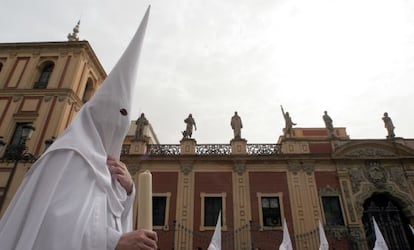The brotherhoods bringing the Passion
Be sure not to miss Spain’s haunting religious processions this Easter

As the country sweeps up after Thursday’s general strike, Spaniards will be preparing to take to the streets once more in the coming days — for the somber processions that traditionally mark Semana Santa, or Easter week.
It’s Andalusia that usually hosts the most spectacular and emotional events marking the Passion and resurrection of Christ. Organized by religious groups (cofradías) and brotherhoods (hermandades) that date back hundreds of years, the processions see ornate and historic sculptures of Christ and the mourning Virgin Mary carried through the streets on heavy floats (pasos) — often weighing over a ton — by their members. Alongside them walk the Nazarenes, members of the same groups, in their cloaks and traditional pointed hoods — about which no foreigner will ever fail to make a crack about the Ku Klux Klan.
During the small hours of Good Friday morning in Seville, the Hermandad de la Esperanza Macarena, the biggest brotherhood in the city, will take out the famous Virgen de la Macarena for an epic 13-hour tour, while the Hermandad de la Esperanza de Triana will carry the similarly loved La Virgen de La Esperanza de Triana.
They are followed in the evening by the processions of the La O and El Cachorro brotherhoods, both based in city’s Triana neighborhood and dating from the 16th and 17th centuries, respectively. The parades of La Trinidad and Santo Entierro brotherhoods are two of the most popular on Easter Saturday, while the Hermandad de La Resurrección, the only procession on Easter Sunday, brings things to a close in the Andalusian capital.
Málaga also sees some of the biggest crowds. Last year Hollywood actor and local boy Antonio Banderas headed the procession of the Virgen de Lágrimas y Favores on Palm Sunday. But the processions are not solely confined to the southern region. The more solemn Semana Santa celebrations of Cuenca have been declared festivals of International Touristic interest.
In Madrid, meanwhile, around 20 processions take place — a good half of those in the city center. Perhaps the most popular is the one leaving from the old Madrid cathedral of Colegiata de San Isidro on Toledo street at 8pm on Maundy Thursday, carrying the figure of Jesús del Gran Poder. Other notable processions include that from the Jesús de Medinaceli church, on Plaza de Jésus near Congress, and the silent, goosebump-inducing El Silencio parade from the Santísimo Cristo de la Fé church (Atocha street), both starting at 7pm on Good Friday, and those of Virgen Dolorosa (8am) and La Soledad (4.30pm) on Easter Saturday.
Tu suscripción se está usando en otro dispositivo
¿Quieres añadir otro usuario a tu suscripción?
Si continúas leyendo en este dispositivo, no se podrá leer en el otro.
FlechaTu suscripción se está usando en otro dispositivo y solo puedes acceder a EL PAÍS desde un dispositivo a la vez.
Si quieres compartir tu cuenta, cambia tu suscripción a la modalidad Premium, así podrás añadir otro usuario. Cada uno accederá con su propia cuenta de email, lo que os permitirá personalizar vuestra experiencia en EL PAÍS.
¿Tienes una suscripción de empresa? Accede aquí para contratar más cuentas.
En el caso de no saber quién está usando tu cuenta, te recomendamos cambiar tu contraseña aquí.
Si decides continuar compartiendo tu cuenta, este mensaje se mostrará en tu dispositivo y en el de la otra persona que está usando tu cuenta de forma indefinida, afectando a tu experiencia de lectura. Puedes consultar aquí los términos y condiciones de la suscripción digital.
Últimas noticias
Most viewed
- Pablo Escobar’s hippos: A serious environmental problem, 40 years on
- Reinhard Genzel, Nobel laureate in physics: ‘One-minute videos will never give you the truth’
- Why we lost the habit of sleeping in two segments and how that changed our sense of time
- Charles Dubouloz, mountaineering star, retires at 36 with a farewell tour inspired by Walter Bonatti
- The Florida Keys tourist paradise is besieged by immigration agents: ‘We’ve never seen anything like this’








































